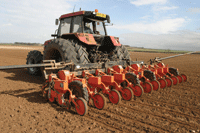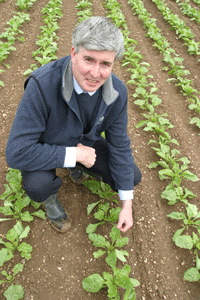Sugar beet bolting – lessons learned from 2008

Was it the unusually cold weather in March and April, the characteristics of new sugar beet varieties or the advice to start drilling at the end of February which caused high levels of bolting in 2008?
Who got it wrong? Was it the breeders, introducing more sensitive varieties, or was it British Sugar, with their first text message of the season going out on 26 February in mild conditions, telling growers to start drilling?
Or was it neither? Just a freak combination of factors, which saw particularly cold weather in March and April creating the sternest test for some time and resulting in levels of bolting which haven’t been seen for more than 20 years.
Mike May of Broom’s Barn says that it was a very unusual year. “We did see ideal drilling conditions in February. But they were then followed by two very cold months.
“It’s not unusual to get a cold March or a cold April, but to get both is. All varieties will bolt if there is a sufficient period of vernalisation.”
He adds that bringing drilling date forward from the beginning of April to the beginning of March typically results in a 10% yield benefit, making it the obvious course of action for most growers.
“That level of benefit more than pays for any handwork needed to get rid of bolters. Early removal proved essential in 2008, as it prevented seed return.”

According to Richard Powell (pictured) of Syngenta, which markets the Hilleshogbrand of sugar beet varieties, there were 41 days of vernalisation between the end of February and the end of April.
“There isn’t a commercial variety out there that could have withstood that test,” he says. “It was an extreme situation.”
Even the Hilleshog varieties, which originate from Scandinavia and are acknowledged to be among the best for bolting, had bolting levels of 5-7%, he reports.
“It can be likened to the sprouting scores for winter wheat,” he says. “There are a couple of varieties with a known weakness. But after three weeks of rain when wheat is in ear, every single one will start to sprout.”
Mr Powell dismisses the suggestion that new sugar beet varieties are less resistant to bolting. “There is some more sensitive material around, but it still withstands 30 days of vernalisation. Of course there are a couple of exceptions, which are more suited to a Continental climate, but otherwise the bolting performance is very good.
“And growers can also look at their scores for early sowing and normal sowing dates on the Recommended List, before making a judgement.”
He adds that the difference between bolting and not bolting can be as little as 5-6 days. “Not enough has been made of risk. Growers know they are taking a risk by drilling early, but many consider the extra yield is worth it.”
However, even those who drilled on 2 April in 2008 still got bolters in their crops, he acknowledges. “That just shows what we were up against.”
His advice for the coming season is to be wary of those varieties which have a high bolting score from normal drilling dates. “That indicates a potential problem. For the others, look at their scores from both sets of trials, early and normal, before deciding.”
The proposal to report bolting as the number of plants per hectare is a sensible move, he believes. “It’s difficult to know what 0.06 bolters means. By giving a per hectare value, growers will get a better idea of what’s acceptable to them.”
Mr Powell also points out that the official early sown trials haven’t been early enough to give meaningful data. “There’s been a suggestion that this is going to be addressed in future work, which is more good news.”
Mr May says soil conditions should be the starting point when it comes to deciding when to begin drilling. “Location also matters – growers in the Fens, where there’s a higher frost risk, or on the Lincolnshire Wolds, where the days are colder, will be taking a bigger gamble if they drill early.”
Varieties all have a ranking for bolting, he says. “Future work is going to concentrate on producing data for individual varieties grown in different conditions. That will add to what we already know.”
Testing proves tricky
Volker Utesch of KWS reckons the UK is the most testing market for bolting.
“In France and Germany, drilling never takes place until the end of March or beginning of April, due to the risk of frost.”
Like Mr Powell, he believes the UK’s early sown trials have been too late. “Our own work showed an average bolting level of 3.1% from 2003 to 2007, when plots were drilled at the end of February. That rose to 43.4% in 2008.”
The Netherlands, which comes close to the UK in terms of bolting, also came unstuck last year. “Bolting levels were 25-30% on all varieties.”
Mr Utesch says the short life of sugar beet varieties – just three to four years – is also a factor. “It’s hard to test varieties in all conditions when they come and go so quickly.”
As a general rule, rhizomania resistant varieties are more susceptible to bolting than conventional varieties, he adds. “But there is advice to accompany all of them.”
Bolting is a complex physiological process, governed by many parameters, he says. “Seed maturity and ripening have effects, as does the position of the plant in the field. Even seed on the same plant will have different bolting habits, according to which direction it faced.
“That’s why we will never be able to say that a particular variety can be sown safely on a particular date. But we can give an indication of whether it is suitable for early, mid or later drilling.”
- For more from Beet 09 click here

